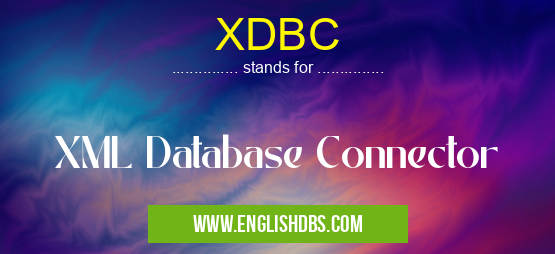What does XDBC mean in
XDBC (XML Database Connector) is a software interface that enables communication between an XML (Extensible Markup Language) document and a database. It provides a standardized method for accessing and manipulating data stored in a database, using XML as the data exchange format. By leveraging XDBC, applications can seamlessly interact with both XML documents and relational databases, facilitating data integration and exchange.

XDBC meaning in in Computing
XDBC mostly used in an acronym in Category Computing that means XML Database Connector
Shorthand: XDBC,
Full Form: XML Database Connector
For more information of "XML Database Connector", see the section below.
» Computing »
Key Features of XDBC
- XML-based Data Exchange: XDBC utilizes XML as the primary format for transmitting data between applications and databases. This enables a consistent and platform-independent mechanism for data exchange.
- Database Connectivity: XDBC supports connectivity to various types of databases, such as SQL-based relational databases, NoSQL databases, and hierarchical databases, allowing for seamless data access across different data sources.
- Data Mapping: XDBC provides data mapping capabilities that allow XML documents to be mapped to database tables and vice versa. This mapping ensures that data is accurately represented in both XML and database formats.
- Query Processing: XDBC enables the execution of queries against XML documents as well as against the underlying database. Queries can be formulated using either XML-based languages, such as XQuery, or database-specific languages, such as SQL.
- Update and Synchronization: XDBC facilitates the update and synchronization of data between XML documents and databases. Changes made to the XML document can be propagated to the database, and vice versa, ensuring data consistency across both sources.
Benefits of Using XDBC
- Improved Interoperability: XDBC enhances interoperability between different applications and data sources by providing a common data exchange format.
- Simplified Data Access: XDBC simplifies data access by enabling the use of XML as a universal data representation, eliminating the need for custom data parsers and handlers.
- Enhanced Data Integration: XDBC facilitates data integration by bridging the gap between XML documents and databases, allowing for seamless data exchange and merging of disparate data sources.
- Increased Productivity: XDBC increases productivity by automating data extraction, transformation, and synchronization tasks, reducing the time and effort required for data management.
Essential Questions and Answers on XML Database Connector in "COMPUTING»IT"
What is XDBC (XML Database Connector)?
XDBC is an open-source Java API for connecting to XML databases. It provides a standard interface for accessing and manipulating XML data stored in a database, regardless of the underlying database vendor or platform.
What are the benefits of using XDBC?
Using XDBC offers several benefits, including:
- Portability: XDBC enables applications to access XML databases from different vendors without modifying the code.
- Interoperability: It allows applications to seamlessly integrate with various XML databases and leverage their features.
- Data integration: XDBC simplifies the integration of XML data with other data sources, providing a comprehensive view of information.
How do I use XDBC?
To use XDBC, you can follow these steps:
- Install the XDBC library in your Java development environment.
- Create an XDBC connection object to establish a connection to the XML database.
- Use XDBC API methods to query, update, and manipulate XML data in the database.
What types of XML databases can XDBC connect to?
XDBC can connect to various XML databases, including:
- Native XML databases: Databases designed specifically for storing and managing XML data, such as MarkLogic and eXist.
- Relational databases with XML support: Databases that provide support for XML data types and XML-related operations, such as Oracle and SQL Server.
- NoSQL databases with XML support: Databases that offer flexible data models and support XML data, such as MongoDB and CouchDB.
What are the limitations of XDBC?
XDBC has some limitations, including:
- Vendor-specific extensions: XDBC provides a standard interface, but vendors may implement additional proprietary features, which may not be accessible through the XDBC API.
- Limited support for some XML features: XDBC may not fully support certain advanced XML features, such as XML Schema validation or XQuery updates.
- Performance overhead: Using XDBC adds an extra layer of abstraction, which may introduce some performance overhead compared to direct database access.
Final Words: XDBC is a powerful and versatile tool that enables efficient communication between XML documents and databases. By standardizing data exchange and providing comprehensive data mapping and query processing capabilities, XDBC simplifies data access, enhances interoperability, and streamlines data integration processes. Its benefits extend across various applications, including data warehousing, content management systems, and enterprise resource planning (ERP) systems.
